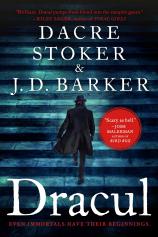Dracul
Review
Dracul
When Bram Stoker walked into the offices of Archibald Constable & Company, he delivered to his UK publishers the manuscript for DRACULA. He stated to them, “This is a true story.” You see, Stoker did not intend for it to serve as a work of fiction but rather as a warning of very real evil.
This true bit of Stoker family history is recounted by Dacre Stoker and J. D. Barker in the Author's Note portion of their brilliant new book, DRACUL. Just like the original novel, this prequel is grounded in truth. Thankfully, the authors had much to draw upon as Stoker retained copious notes of his thought process throughout his creation of DRACULA.
When I learned last year that these two writers were teaming up to produce a prequel to DRACULA, I could not contain myself. I thoroughly enjoyed Dacre's 2009 sequel, DRACULA THE UN-DEAD, which he co-wrote with Ian Holt. As Stoker's great-grandnephew, Dacre provides much personal history and credibility to his works. Barker is an award-winning writer who is the second coming of Thomas Harris, with his terrific 4MK serial killer series (THE FOURTH MONKEY and THE FIFTH TO DIE).
The protagonist of DRACUL is Bram Stoker himself. Ironically, this is the second novel in the last month I have read that features Stoker as a character (the other being Robert Masello's THE NIGHT CROSSING). DRACUL is one of the most frightening stories I have ever read, and it is ideally released during the Halloween season. It is the type of book that begs to be read by candlelight or next to a roaring fire, peeking over your shoulder the entire time to ensure you are still safe. The novel is dedicated to “all those who know monsters are real.” By the end of this one, you may be a believer as well…or, at the very least, be scared out of your wits.
The story commences in Bram Stoker's present day, which is well after the events that are described within. He begins to write in his journal to recount the nightmare that his life has become and how it all began. The principal character in these entries is Ellen Crone; she was more familiar to young Bram as Nanna Ellen, who lived with his family in Dublin and helped care for the Stoker children. An early journal entry features Bram's sister, Matilda, uttering the phrase “Buried alive.” She overheard their parents discussing a matter in which an allegedly sick man was buried alive in the graveyard next to their local church.
Bram and Matilda make quite the team, and their story finds them forever bonded by the events that they will live through during their young lives. They both recall how Nanna Ellen would often disappear for several days, at times without warning. Upon her return, she would not speak of where she went or what she did, but somehow she always came back looking like her youthful self again. Their Irish village is rocked by scandal when a man named Patrick O'Cuiv reportedly slaughtered his own family and was later found bleeding profusely from both arms.
"You can clearly see the marriage of prose between Dacre Stoker and J. D. Barker --- Stoker's firm grasp of his family history and Barker's storytelling skills, which constantly provide plot twists and surprises."
The very imaginative and suspicious Bram and Matilda begin to tune into Ellen, trying to decipher what she was really all about. One of the most significant events that come out of their curiosity is when Bram breaks into her room to snoop around. What he finds horrifies and perplexes him --- a bed of dirt underneath her own mattress, filled with squirming maggots and other items. Shortly after, Bram is suddenly taken by a grave illness with a deadly high fever that would surely claim his life. His Uncle Edward is called to help, and his only suggestion for a cure is to cover the boy in leeches to clean out his blood. This is not what cures Bram, though; it was actually the return of Ellen that did the trick. In a dream-like state, Bram recalls her coming to his bedside in the middle of the night and doing something to him that allowed him to awaken the next morning fully cured of his ailment.
Bram's parents never acknowledge the work of Ellen as playing any part in saving their son, and instead decide to release her from duty due to her constant vanishing acts and purported unreliability. Before that can happen, she disappears again, this time taking all of her belongings with her --- including the dirt bed in her small room. Bram still feels some odd bond to Ellen, almost as if they can psychically connect with each other, and he is determined to find her again. He and Matilda begin their search at Artane Tower, a location to which he feels Ellen has some connection. There they find a closed room that appears to have been hers. They open up an old box and discover an ancient ring featuring a dragon with rubies for eyes, as well as an inscription on the inside of the band that reads "Casa lui Dracul."
The rest of the story is told from journal entries, not only from Bram's hand but also in copies of letters Matilda writes to Ellen; journal entries of their older brother, Thornley; and information from other characters they will meet during their quest to solve the mystery of Ellen Crone. Thornley, who will grow up to be one of the most respected doctors of his time, joins forces with Bram and Matilda as his own dreams have been haunted by the figure of Patrick O'Cuiv, which reconfirm for him his decision not to have a family with his wife, Emily.
The Stoker siblings all have stories in which they swear they saw Ellen. When dozens of mysterious deaths force bodies to pile up in the morgue, Thornley takes Bram and Matilda to the mortuary at his hospital to investigate some of the corpses, which were were laid out with bells tied to them. There is one especially chilling scene where the siblings race from the mortuary to a peal of bells, seemingly coming from dozens of supposedly lifeless corpses. Thornley introduces them to a man named Arminius Vambery, who reads from an old story found in Dublin's mysterious Hellfire Club that was penned in 1654 by the Countess Dolingen von Gratz. That is who the siblings believe their Nanna to actually be.
The group heads out to find Ellen and are continually coming upon other beings who look remarkably like members of the O'Cuiv family, including the young daughter, Maggie. There is a moment when Matilda is awakened from sleep by the hovering body of Patrick O'Cuiv tapping at her bedroom window with yellowed fingernails that resemble talons. This brought me right back to an equally chilling scene in Stephen King's SALEM'S LOT. It is clear that vampire lore was being strictly adhered to, and the characteristics were passed down in modern-day stories just as they were in journals and bits of oral history for centuries.
When Emily appears to have been bitten and turned into a vampire, it becomes urgent that they find out who is behind all of this. Ellen may have existed for ages, but there is another ancient creature that was responsible for starting all of the current horror they are experiencing --- the same creature that originally turned Ellen into the now immortal being that she is. It is well into the novel when we are introduced to Dracul, and Vambery knows well the history of the ancient Dracul family born in the mountains of Wallachia. They realize that this evil creature was the one now referred to as Dracula, and an epic showdown involving Bram Stoker and his group, Ellen, Dracula and legions of the undead is where this spellbinding work is leading --- and it's a jaw-dropping spectacle of tension and fear.
You can clearly see the marriage of prose between Dacre Stoker and J. D. Barker --- Stoker's firm grasp of his family history and Barker's storytelling skills, which constantly provide plot twists and surprises. At one point towards the end of the novel, we leap far forward to author and theater owner Bram Stoker being visited by a woman calling herself Mina Harker. She hands him a bound manuscript that features the words found dead center on the first page: COUNT WAMPYR. This is all Stoker needed to fuse with his own experience to pen DRACULA.
Whether or not you believe this tale to be spun from truth is a matter of personal opinion. I enjoyed it immensely, and found DRACUL more than worthy to stand beside Bram Stoker's classic novel. If it happens to be true, well, that is something for me to sort out in my own nightmares that were nicely fueled by Stoker and Barker.
Reviewed by Ray Palen on October 12, 2018





